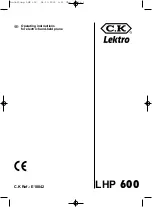
1. kNOW YOUR TOOL
Read and understand the owners manual and labels affixed to the
tool. Learn its application and limitations as well as its specific
potential hazards.
2. GROUND THE TOOL.
This tool is equipped with an approved 3-conductor cord and a
3-prong grounding type plug to fit the proper grounding type
receptacle. The green conductor in the cord is the grounding wire.
NEVER
connect the green wire to a live terminal.
3. kEEP GUARDS IN PLACE.
Keep in good working order, properly adjusted and aligned.
4. REMOVE ADJUSTING kEYS AND
WRENCHES.
Form habit of checking to see that keys and adjusting wrenches
are removed from tool before turning it on.
5. kEEP WORk AREA CLEAN.
Cluttered areas and benches invite accidents. Make sure the floor
is clean and not slippery.
6. AVOID DANGEROUS ENVIRONMENT.
Don’t use power tools in damp or wet locations or expose them to
rain. Keep work area well lit and provide adequate surrounding
work space.
7. kEEP CHILDREN AWAY.
All visitors should be kept a safe distance from work area.
8. MAkE WORkSHOP CHILD-PROOF.
-with padlocks, master switches or by removing starter keys.
9. USE PROPER SPEED.
A tool will do a better and safer job when operated at the proper
speed.
10. USE RIGHT TOOL.
Don’t force the tool or the attachment to do a job for which it was
not designed.
11. WEAR PROPER APPAREL.
Do not wear loose clothing, gloves, neckties or jewelry (rings,
watch) because they could get caught in moving parts. Non-slip
footwear is recommended. Wear protective hair covering to contain
long hair. Roll up long sleeves above the elbows.
12. ALWAYS WEAR SAFETY GLASSES.
Always wear safety glasses (ANSI Z87.1). Everyday eye-glasses
only have impact resistant lenses, thet are
NOT
safety glasses.
Also use a face or dust mask if cutting operation is dusty.
13. DON’T OVERREACH.
Keep proper footing and balance at all times.
14. MAINTAIN TOOL WITH CARE.
Keep tools sharp and clean for best and safest performance. Follow
instructions for lubricating and changing accessories.
15. DISCONNECT TOOLS.
Before servicing, when changing accessories or attachments.
16. AVOID ACCIDENTAL STARTING.
Make sure the swich is in the ‘’OFF’’ position before plugging in.
17. USE RECOMMENDED ACCESSORIES.
Consult the manual for recommended accessories. Follow the in-
structions that accompany the accessories. The use of improper
accessories may cause hazards.
18. NEVER STAND ON TOOL.
Serious injury could occur if the tool tips over. Do not store materials
such that it is necessary to stand on the tool to reach them.
19. CHECk DAMAGED PARTS.
Before further use of the tool, a guard or other parts that are
damaged should be carefully checked to ensure that they will
operate properly and perform their intended function. Check for
alignment of moving parts, breakage of parts, mounting, and any
other conditions that may affect its operation. A guard or other parts
that are damaged should be properly repaired or replaced.
20. NEVER LEAVE MACHINE RUNNING
UNATTENDED.
Turn power ‘’OFF’’. Don’t leave any tool running until it comes to a
complete stop.
SPECIFIC SAFETY RULES FOR PLANERS WITH SPIRAL
CUTTERHEAD
Safety is a combination of common sense, staying alert and knowing
how your planer works. Read and understand the following safety rules
before operating.
1. For your own safety, read the entire instruction manual before
operating the planer.
2. Be sure that the cutterhead inserts are securely installed in the
cutterhead.
3. Always use clean, properly sharpened inserts. Dirty or dull inserts
are unsafe and can lead to accidents.
4. Do not push or force stock into the cutterhead. The planer will
perform better and more safely when working at the rate for which it
was designed.
5. Be sure that the cutterhead has gained full operating speed before
starting to plane a workpiece.
6. Inspect stock and remove all foreign objects before planing. Make
sure that any stock you plane is clean and free of any dirt, nails,
staples, tiny rocks or any other foreign objects that may damage
the planer knives. Only process natural solid wood boards. Never
plane MDF, particle board, plywood, laminates or other synthetic
materials.
7. Do not operate this planer when tired, distracted, or under the effects
of drugs, alcohol or any medication that impairs reflexes or
alertness.
8. Keep guards in place and in working order. If a guard must be
removed for maintenance or cleaning be sure it is properly
re-attached before using the tool again.
9. Kickback is when the workpiece is ejected at high speeds by the
force of the cutterhead. To minimize the risk of injury from kickback,
use proper feeding technique and stand to one side, out of the path
of a potential kickback.
10. Place stock firmly against the table and use suitable in-feed and
out-feed support if stock is too long.
GENERAL & SPECIFIC
SAFETY RULES































